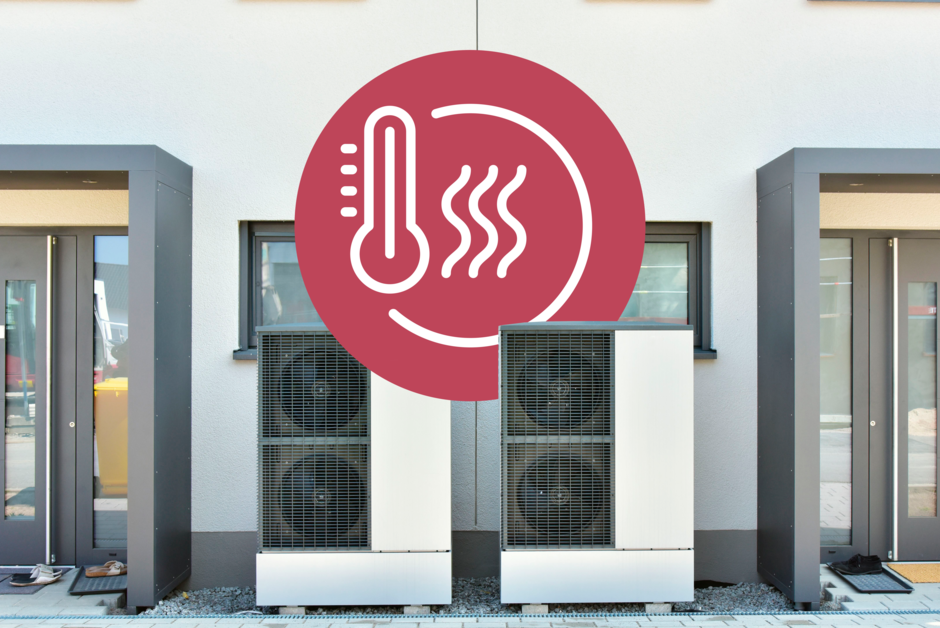Innovation area I
High-temperature large heat pumps
The research focuses on high-temperature heat pumps (HT-HP) with an increasing useable temperature level and, the adaption of environmentally friendly refrigerants. Research on thermodynamic cycle processes with natural refrigerant mixtures such as ammonia/water is an important part of the research work. The Challenges are the thermodynamic optimisation of the system as well as the development of flexible thermal storage systems.

Sub-project I.1
Defining the requirements for large heat pumps with thermal storage units
In this sub-project, external boundary conditions for large heat pumps with thermal storage tanks are determined through literature research and industry surveys. Static (e.g. temperature levels, temperature differences) and dynamic (e.g. temporal heat demand, availability of heat sources) factors are taken into account.
On this basis, thermodynamic cycle processes, refrigerants, storage materials and power supply options are selected.
The aim is to develop phase change storage systems for heating networks and industrial applications in combination with HT heat pumps, taking into account dynamics, temperature levels and storage requirements.
Researchers
Prof. Dr.-Ing. Ines Hauer
TU Clausthal
Sub-project I.2
Creation of model libraries for material data, heat pump components, heat storage and system models
A design tool for thermodynamic cycle processes with heat storage is being developed, which includes the modelling of large heat pumps with two-component working fluids and macro-encapsulated PCM layer storage.
Macroscopic kinetics to describe the solid-liquid phase transitions and the hysteresis of long-chain alkane nanocomposites and alkane polyoxymethylene are being developed for the modelling of the thermal layer storage (TUC-IEVB) with the aid of experimental material data generation.
The results will be validated there after the construction of the test rig (SP I.3).
Researchers
Prof. Dr. Michael Fischlschweiger
TU Clausthal
Sub-project I.3
Planning and construction of test benches
The planned construction of laboratory test benches in this WP serves the experimental validation and parameterisation of model libraries.
Three laboratory test benches are planned: At the IfT of the LUH, a compression heat pump with an ammonia/water mixture and 60 kW output will be adapted to validate model libraries of two-phase mixture condensation and evaporation. A test rig for PCM nanocomposites in the temperature range 70 - 200 °C is being set up at the IEVB of the TUC.
The ISFH is building a modular laboratory test rig to analyse various compression cycle processes and refrigerant mixtures.
Researchers
Maximilian Loth
Institut für Solarenergieforschung in Hameln (ISFH)
Sub-project I.4
Planning and carrying out measurements on the test benches to validate the model libraries created
Following the successful implementation of SP I.3, laboratory test benches are available for the optimisation and validation of the model libraries.
Heat pump components, storage materials, storage design and cycle process configurations will be analysed. Measurements of heat transfer coefficients with different mixture compositions are carried out at the IfT. At the ISFH, various cycle process configurations and heat transfer processes for two-component systems such as acetone-carbon dioxide are being investigated.
Macro-encapsulated PCM modules are tested at different temperature levels on the TUC storage test bench, with the findings being incorporated into the model libraries.
Researchers
Prof. Dr.-Ing. Stephan Kabelac
Leibniz Universität Hannover
Sub-project I.5
Creating a design tool for the requirements-based planning of large heat pump systems with thermal storage tanks
In this sub-project, interviews are conducted with potential users to determine their requirements. This is followed by an analysis of standards and guidelines for large heat pump systems and thermal storage tanks.
Before developing in-house design tools, existing software solutions are researched and evaluated. A concept for the tool is created, prototypes for visualising the user interface are developed and the software is programmed. The integration and validation of the calculation algorithms is carried out continuously.
The final documentation takes into account legal requirements and the market availability of components.
Researchers
Prof. Dr.-Ing. Stephan Kabelac
Leibniz Universität Hannover
Sub-project I.6
Realisation of a system with users and associated partners
This sub-project begins with an analysis of the requirements of a local user and the industrial partners. A concept for the large heat pump system is then developed and suitable technologies and components are selected. The design tool created in SP I.5 will be continuously reviewed and improved.
The system is planned in collaboration with the user and partners, with the goal of bringing it into operation by the end of the project.
Researchers
Maximilian Loth
Institut für Solarenergieforschung in Hameln (ISFH)